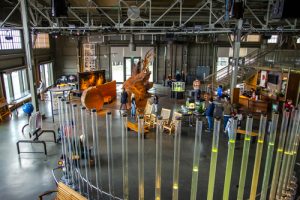Exploratorium
Exploratorium was founded in 1969 by the educator Frank Oppenheimer. Throughout its existence, it positioned itself as an experimental museum and learning center that inspires progress and instills a passion for science. The center has preserved its participatory nature today, encouraging exhibit attendees to take an active role in experiments carried out by bright scientists and teachers. The center has also a massive education impact, organizing learning courses for people seeking to acquire elevated knowledge in certain science fields. Moreover, teachers all over the country can increase their qualifications by attending Exploratorium’s comprehensive courses. 
Museum layout
Exploratorium is divided into 6 pavilions dedicated to experiments in different fields. Each gallery has exhibits related to the category it represents and, most of the time, will try to provide a creative and engaging explanation to certain phenomena.
West Gallery: Human Behavior
In West Gallery, human behavior is the one that takes the center stage. The room focuses on human perception and social interaction, encouraging visitors to research and experiment on memory, emotion, analysis, and other cognitive features of the human brain. They are also invited to investigate the way people interact, how trust is built, how to identify a liar, or why sharing is crucial in a community. Representative exhibits come to feed your curiosity and inspire to dive deeper into your human behavior investigation. Some of the artworks are “Poker Face” focusing on the art of bluffing and “Trust Fountain” triggering analysis of the Prisoner’s Dilemma.
South Gallery: Tinkering
The tinkering pavilion allows visitors to engage in hands-on activities where they can create and renovate by themselves. Guided by a teacher, they are encouraged to take part in captivating experiments featuring electricity and magnetism, make artisan items and even create their own animated movie using the animation stations available.
Central Gallery: Seeing and Listening
Central Gallery investigates people’s ability to see and listen, focusing on how people tell colors, how they perceive sound and why optical illusions occur. Aside from being an object to be watched, each exhibit incites people to investigate. For example, a giant reflection mirror makes the visitors analyze how their body is reflected in the mirror.
East Gallery: Living Systems
Biology geeks are encouraged to visit the East Gallery which puts an emphasis on living systems. The exhibits feature various organisms, allowing visitors to see amazing things that observing in daily life is impossible, like the mouse’s stem cell under the microscope or the dissection of a cow eye. The exhibit called “Live Chicken Embryo” shows the chicken embryo at different stages of its evolution inside the egg.
Outdoor Gallery
The Outdoor Gallery is located outside so that visitors can investigate the weather. They have the chance to notice wind shifts, water color changes, cloud movement patterns as well as take a look at the Fog Bridge. The Fog Bridge is an installation that artificially creates fog. In this way, the creator of the bridge wanted to encourage people to invest more time in researching a popular weather phenomenon in San Francisco such as fog.
Fisher Bay Observatory Gallery
The Fisher Bay Observatory offers an unobstructed view to the outside world having all walls of glass. The observatory allows visitors to watch the tides, assess the behavior of clouds and track the ships’ movement. The gallery has a topographic map that provides real-time data about the speed and direction of fog, the salinity of water and the changing waterfront.
Learning experiences
Exploratorium provides a variety of education programs, both at distance and in person, targeting teachers, students and underprivileged children. Curated by leading science educators and experimentators, the courses help students deepen their knowledge in science and boost their practical skills. Teaching programs focus on the improvement of the practical preparation of science teachers.
Is it worth visiting?
Exploratorium is definitely worth visiting if you are fond of science and are extremely curious about everything that happens around you. Besides admiring the beauty of the exhibits, you will be able to dive into their meaning and investigate the issue presented by them. You will get the chance to participate in captivating experiments related to human perception and community behavior, create your own animated movie, observe the tides and shifting winds and many other activities that will broaden your horizons.

